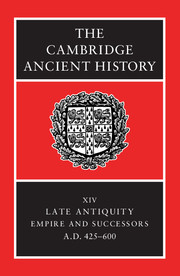Book contents
- Frontmatter
- PART I CHRONOLOGICAL OVERVIEW
- PART II GOVERNMENT AND INSTITUTIONS
- PART III EAST AND WEST: ECONOMY AND SOCIETY
- PART IV THE PROVINCES AND THE NON-ROMAN WORLD
- PART V RELIGION AND CULTURE
- 24 The organization of the church
- 25 Monasticism
- 26 Holy Men
- 27 The definition and enforcement of orthodoxy
- 28 Philosophy and philosophical schools
- 29 Education in the Roman empire
- 30 The visual arts
- 31 Building and architecture
- Conclusion
- Chronological Table
- BIBLIOGRAPHY
- Index
- References
30 - The visual arts
from PART V - RELIGION AND CULTURE
Published online by Cambridge University Press: 28 March 2008
- Frontmatter
- PART I CHRONOLOGICAL OVERVIEW
- PART II GOVERNMENT AND INSTITUTIONS
- PART III EAST AND WEST: ECONOMY AND SOCIETY
- PART IV THE PROVINCES AND THE NON-ROMAN WORLD
- PART V RELIGION AND CULTURE
- 24 The organization of the church
- 25 Monasticism
- 26 Holy Men
- 27 The definition and enforcement of orthodoxy
- 28 Philosophy and philosophical schools
- 29 Education in the Roman empire
- 30 The visual arts
- 31 Building and architecture
- Conclusion
- Chronological Table
- BIBLIOGRAPHY
- Index
- References
Summary
Under detailed scrutiny, the period from 425 to 600 is seen to represent a time of significant and conspicuous artistic production and stylistic change and complexity. If the fourth century appears a time of transition, yet dominated by traditional forms and techniques, then in contrast it is easy to see that the fifth century witnesses considerable change, and that by 600 the forms of Christian art have become distinctive, and many of the aspects of later medieval art have been determined. This is the period which produced the present church of St Sophia at Constantinople (532–7), one of the most dramatic and influential buildings in world architecture. This achievement alone gives the period an identity in its own right. Yet in the broad view, it is clear that Christianity adapted rather than rejected the values of classical ‘pagan’ art. Hence the predominant discussions of the art of this period in terms of continuity and change, or – put more precisely – in terms of classical and non-classical elements, and either their interplay or their independence.
This priority for the art-historical analysis of these centuries is superfically justifiable, but one soon suspects that it may mask a whole set of more serious problems. It may, however, still offer a way of identifying the strengths and weaknesses of the current state of research; the question of the stage of ‘classicism’ embodied in the art of this period should not necessarily be evaded, so long as one remains aware that it encourages the framing of questions in terms of style, and identifies the issues from the surface appearance.
- Type
- Chapter
- Information
- The Cambridge Ancient History , pp. 884 - 917Publisher: Cambridge University PressPrint publication year: 2001
References
- 1
- Cited by

